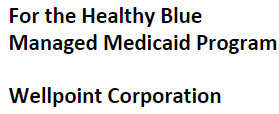
 | Clinical UM Guideline |
| Subject: Assistant Surgeons | |
| Guideline #: CG-SURG-50 | Publish Date: 06/28/2024 |
| Status: Reviewed | Last Review Date: 05/09/2024 |
| Description |
This document addresses use of an assistant during surgical procedures. An assistant at surgery refers to a licensed professional who actively participates with the operating surgeon who is performing a surgical procedure. This document does not address use of a co-surgeon or team of surgeons.
| Clinical Indications |
Medically Necessary:
Use of one assistant surgeon during a surgical procedure may be considered medically necessary when the following criteria are met:
Not Medically Necessary:
The use of an assistant surgeon during surgery is considered not medically necessary for the following:
| Discussion/General Information |
ACS (2013) has defined an assistant surgeon as someone “who is able to participate in and actively assist the surgeon in completing the operation safely and expeditiously by helping to provide exposure, maintain hemostasis, and serve other technical functions.” An assistant surgeon generally refers to a medical doctor (MD), Doctor of Podiatric Medicine (D.P.M.), Doctor of Dental Surgery (D.D.S.), or Doctor of Osteopathy (D.O.). ACS indicates that at times, it may also be appropriate to use other licensed allied health professionals such as a physician’s assistant (PA), clinical nurse specialist (CNS), nurse practitioner (NP) or registered nurse first assistant (RNFA).
ACS has determined that assistant surgeon services are required for the successful completion of certain surgical procedures that have been identified as sufficiently complex or intensive in the sixth edition of their study, Physicians as Assistants at Surgery (2023*), which was developed in collaboration with 15 other specialty societies. The study was undertaken by examining all of the codes listed in the American Medical Associations (AMA) Current Procedural Terminology (CPT TM) 2020. The organizations in collaboration with the ACS, were asked to review each code and indicate if surgical procedures required the use of an assistant surgeon “almost always,” “almost never,” or “sometimes.”
Similar to the ACS, CMS has designated surgical procedures with verbiage akin to “always,” “sometimes,” or “never” requiring a surgical assistant based on the frequency of use documented in the CMS Medicare Physician Fee Schedule (MPFS) database in effect at the time of service (also referred to as the Relative Value File). The list is applicable to first assistants, MDs, PAs and NPs.
Assistant at Surgery
Indicates services where an assistant at surgery is never paid for per Medicare Claims Manual.
0=Payment restriction for assistants at surgery applies to this procedure unless supporting documentation is submitted to establish medical necessity.
1 = Statutory payment restriction for assistants at surgery applies to this procedure. Assistant at surgery may not be paid.
2 = Payment restriction for assistants at surgery does not apply to this procedure. Assistants at surgery may be paid.
9 = Concept does not apply [e.g., procedures during which use of an assist surgeon would not be considered].
*If there is a more recent version available of the ACS’s Physicians as Assistants at Surgery publication, it supersedes the version and link listed in the Reference section of this document.
| Definitions |
Assistant surgeon: A practitioner who actively assists the operating surgeon. An assistant may be necessary because of the complex nature of the procedure(s) or the individual’s condition. The assistant surgeon is usually trained in the same specialty.
Co-surgeons: Two or more surgeons, where the skills of both surgeons are necessary to perform distinct parts of a specific operative procedure.
Team of surgeons: More than two surgeons, usually of different specialties, where the skills of each are necessary to perform distinct parts of a specific operative procedure.
| References |
Peer Reviewed Publications:
Government Agency, Medical Society, and Other Authoritative Publications:
| History |
| Status | Date | Action |
| Reviewed | 05/09/2024 | Medical Policy & Technology Assessment Committee (MPTAC) review. Updated Discussion/General Information and References sections. |
| Reviewed | 05/11/2023 | MPTAC review. Updated Discussion/General Information and References sections. |
| Reviewed | 05/12/2022 | MPTAC review. Updated References section. |
| Reviewed | 05/13/2021 | MPTAC review. Updated Discussion/General Information and References sections. |
| Reviewed | 05/14/2020 | MPTAC review. Updated Discussion/General Information and References sections. |
| Reviewed | 06/06/2019 | MPTAC review. Updated References section. |
| Reviewed | 07/26/2018 | MPTAC review. The document header wording updated from “Current Effective Date” to “Publish Date.” Updated Discussion/General Information and References sections. |
| Reviewed | 08/03/2017 | MPTAC review. Updated Discussion/General Information and References sections. |
| Reviewed | 08/04/2016 | MPTAC review. Updated Discussion/General Information and References sections. |
| New | 08/06/2015 | MPTAC review. Initial document development. |
Federal and State law, as well as contract language including definitions and specific coverage provisions/exclusions, and Medical Policy take precedence over Clinical UM Guidelines and must be considered first in determining eligibility for coverage. The member's contract benefits in effect on the date that services are rendered must be used. Clinical UM Guidelines, which address medical efficacy, should be considered before utilizing medical opinion in adjudication. Medical technology is constantly evolving, and we reserve the right to review and update Clinical UM Guidelines periodically. Clinical UM guidelines are used when the plan performs utilization review for the subject. Due to variances in utilization patterns, each plan may choose whether or not to adopt a particular Clinical UM Guideline. To determine if review is required for this Clinical UM Guideline, please contact the customer service number on the back of the member's card.
No part of this publication may be reproduced, stored in a retrieval system or transmitted, in any form or by any means, electronic, mechanical, photocopying, or otherwise, without permission from the health plan.